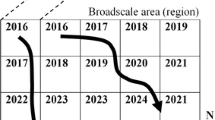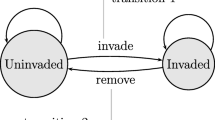Abstract
Eradication of invasive species can have substantial benefits but programs often fail and have high costs. Costs can be reduced by substituting lower cost management actions for higher cost actions that have a similar impact on the probability of eradication. A first step towards minimizing costs is to determine all combinations of management actions that achieve eradication with the same probability, which is a form of trade-off analysis. Trade-off analysis can have a high computational cost when large numbers of management alternatives are compared with a complex spatial simulation model. Here, we apply a practical method for conducting trade-off analysis in which statistical methods are applied to data generated by a complex spatial model to derive a simpler model (the meta-model) that is used to determine trade-offs. We demonstrate this approach with a case study focusing on Australia’s largest eradication program, the campaign to eradicate red imported fire ants (Solenopsis invicta). Trade-offs were estimated for two surveillance methods, remote surveillance and ground surveillance, that are currently used in the eradication program. The methods are applied adaptively, with remote surveillance applied over all potentially infested locations (“area-wide surveillance”) and ground surveillance applied near remotely sensed detection points to find and remove remaining undetected individuals (“local surveillance”). The meta-modelling approach provided useful insights for management. When area-wide and local surveillance methods are applied adaptively, increases in the sensitivity of area-wide surveillance can allow for large reductions in the area of local surveillance and treatment. This can potentially result in substantial cost savings in circumstances where local search methods have a high cost.




Similar content being viewed by others
References
Baxter PWJ, Possingham HP (2011) Optimizing search strategies for invasive pests: learn before you leap. J Appl Ecol 48:86–95
Beattie BR, Taylor CR (1985) The economics of production. Wiley, New York
Bogich TL, Liebhold AM, Shea K (2008) To sample or eradicate? A cost minimization model for monitoring and managing an invasive species. J Appl Ecol 45:1134–1142
Bryson M, Reid A, Hung C, Ramos FT, Sukkarieh S (2014) Cost-effective mapping using unmanned aerial vehicles in ecology monitoring applications. In: Khatib O, Kumar V, Sukhatme G (eds) Experimental robotics. Springer, Berlin, pp 509–523
Cacho OJ, Hester SM (2011) Deriving efficient frontiers for effort allocation in the management of invasive species. Aust J Agric Resour Econ 55:72–89
Cacho OJ, Spring D, Pheloung P, Hester S (2006) Evaluating the feasibility of eradicating an invasion. Biol Invasions 8:903–917
Cacho OJ, Hester S, Spring D (2007) Applying search theory to determine the feasibility of eradicating an invasive population in natural environments. Aust J Agric Resour Econ 51:425–443
Cacho OJ, Hester S, Spring D, Mac Nally R (2010) Allocating surveillance effort in the management of invasive species: a spatially-explicit model. Environ Model Softw 25:444–454
Coutts SR, Yokomizo H (2014) Meta-models as a straightforward approach to the sensitivity analysis of complex models. Popul Ecol 56:7–19
Coutts SR, van Klinken RD, Yokomizo H, Buckley YM (2011) What are the key drivers of spread in invasive plants: dispersal, demography or landscape: and how can we use this knowledge to aid management? Biol Invasions 13:1649–1661
Epanchin-Niell RS, Hastings A (2010) Controlling established invaders: integrating economics and spread dynamics to determine optimal management. Ecol Lett 13:528–541
Epanchin-Niell RS, Wilen JE (2012) Optimal spatial control of biological invasions. J Environ Econ Manag 63:260–270
Epanchin-Niell RS, Haight RG, Berec L, Kean JM, Liebhold AM (2012) Optimal surveillance and eradication of invasive species in heterogeneous landscapes. Ecol Lett 15:803–812
Haight RG, Cypher B, Kelly PA, Phillips S, Possingham HP, Ralls K, Starfield AM, White PJ, Williams D (2002) Optimizing habitat protection using demographic models of population viability. Conserv Biol 16:1386–1397
Haight RG, Cypher B, Kelly PA, Phillips S, Ralls K, Possingham HP (2004) Optimizing reserve expansion for disjunct populations of San Joaquin kit fox. Biol Conserv 117:61–72
Hester SM, Brooks S, Cacho OJ, Panetta FD (2010) Applying a simulation model to the management of an infestation of Miconia calvescens in the wet tropics of Australia. Weed Res 50:269–279
Hester SM, Cacho OJ, Panetta FD, Hauser CE (2013) Economic aspects of post-border weed risk management. Divers Distrib 19:580–589
Hu W, Bulusu N, Chou CT, Jha S, Taylor A, Tran VN (2009) Design and evaluation of a hybrid sensor network for cane toad monitoring. ACM Transactions on Sensor Networks (TOSN), 5
Hung C, Bryson M, Sukkarieh S (2012) Multi-class predictive template for tree crown detection. ISPRS J Photogramm Remote Sens 68:170–183
Keith JM, Spring D (2013) Agent-based Bayesian approach to monitoring the progress of invasive species eradication programs. PNAS 110:13229–13230. doi:10.1073/iti3313110
Lass LW, Prather TS, Glenn NF, Weber KT, Mundt JT, Pettingill J (2009) A review of remote sensing of invasive weeds and example of the early detection of spotted knapweed (Centaurea maculosa) and babysbreath (Gypsophila paniculata) with a hyperspectral sensor. Weed Sci 53:242–251
Lofgren CS, Banks WA, Glancey BM (1975) Biology and control of imported fire ants. Annu Rev Entomol 20:1–30
Mankin RW, Smith MT, Tropp JM, Atkinson EB, Jong DY (2008) Detection of Anoplophora glabripennis (Coleoptera: Cerambycidae) larvae in different host trees and tissues by automated analyses of sound-impulse frequency and temporal patterns. J Econ Entomol 101:838–849
Mayo JH, Straka TJ, Leonard DS (2003) The cost of slowing the spread of the gypsy moth (Lepidoptera: Lymantriidae). J Econ Entomol 96:1448–1454
McCarthy MA, Burgman MA, Ferson S (1995) Sensitivity analysis for models of population viability. Biol Conserv 73:93–100
Mehta SV, Haight RG, Homans FR, Polasky S, Venette RC (2007) Optimal detection and control strategies for invasive species management. Ecol Econ 61:237–245
Morrill WL (1974) Production and flight of alate red imported fire ants. Environ Entomol 3:265–271
Müllerová J, Pergl J, Pyšek P (2013) Remote sensing as a tool for monitoring plant invasions: testing the effects of data resolution and image classification approach on the detection of a model plant species Heracleum mantegazzianum (giant hogweed). Int J Appl Earth Obs Geoinf 25:55–65
Panetta FD (2007) Evaluation of weed eradication programs: containment and extirpation. Divers Distrib 13:33–41
Panetta FD, Cacho O, Hester S, Sims-Chilton N, Brooks S (2011) Estimating and influencing the duration of weed eradication programmes. J Appl Ecol 48:980–988
Polasky S, Nelson E, Lonsdorf E, Fackler P, Starfield A (2005) Conserving species in a working landscape: land use with biological and economic objectives. Ecol Appl 15:1387–1401
Polasky S, Nelson E, Camm J, Csuti B, Fackler P, Lonsdorf E, Montgomery C et al (2008) Where to put things? Spatial land management to sustain biodiversity and economic returns. Biol Conserv 141:1505–1524
Schmidt D, Spring D, Mac Nally R, Thomson JR, Brook B, Cacho O, McKenzie M (2010) Finding needles (or ants) in haystacks: predicting locations of invasive organisms to inform eradication and containment. Ecol Appl 20:1217–1227
Simberloff D (2009) We can eliminate invasions or live with them. Successful management projects. Biol Invasions 11:149–157
The Mathworks (2005) Using MATLAB. The Mathworks, Matick
Turner W, Spector S, Gardiner N, Flodeland M, Sterling E, Steininger M (2003) Remote sensing for biodiversity science and conservation. Trends Ecol Evol 18:306–314
Vitousek PM, D’Antonio CM, Loope LL, Westbrooks R (1996) Biological invasions as global environmental change. Am Sci 84:468–478
Vogt JT, Wallet BC (2008) Feasibility of using template-based and object-based automated detection methods for quantifying black and hybrid imported fire ant (Solenopsis invicta and S. invicta × richteri) mounds in aerial digital imagery. The Rangeland Journal 30:291–295
Acknowledgments
Data were provided by Robert Bell from Biosecurity Queensland Control Centre (BQCC), Craig Jennings from BQCC provided helpful advice and Dane Panetta provided useful comments. We acknowledge financial and other support provided by the National Red Imported Fire Ant Eradication Program.
Author information
Authors and Affiliations
Corresponding author
Electronic supplementary material
Below is the link to the electronic supplementary material.
Rights and permissions
About this article
Cite this article
Spring, D., Cacho, O.J. Estimating eradication probabilities and trade-offs for decision analysis in invasive species eradication programs. Biol Invasions 17, 191–204 (2015). https://doi.org/10.1007/s10530-014-0719-9
Received:
Accepted:
Published:
Issue Date:
DOI: https://doi.org/10.1007/s10530-014-0719-9




